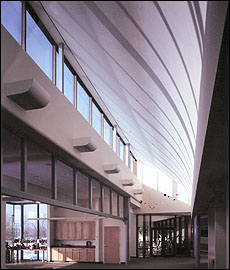Archives
Project wins UB architect local AIA award
MacKay designs space for frail elderly suffused with light, warmth and social ease
By PATRICIA DONOVAN
Contributing Editor
The project called for the design of a 24,000-square-foot day-care center for patients with Alzheimer's disease and a 120-unit housing complex for the frail elderly.
Architect Kenneth MacKay coupled his knowledge of the psychological, aesthetic and emotional effects of natural light with the special requirements of facilities that serve the elderly, their hands-on staff and the clients they serve. The result is the Total Aging in Place Project (TAIPP) for the Weinberg Campus in Amherst, which won this year's Best New Construction Award from the Western New York chapter of the American Institute of Architects.

Architect Ken MacKay has won an award for his Total Aging in Place Project, which utilizes natural light for a space that serves the elderly and their hands-on staff.
MacKay, assistant professor in the School of Architecture and Planning, says initial planning involved Loraine Hiat, a specialist in facility planning for the elderly, and led to a "social" design that permits staff and clients to interact comfortably and move fluidly within a space that has multiple social and medical uses.
"The day-care center itself is used by many who do not live in the adjoining apartment building and by many frail elderly who do not have Alzheimer's but require a broad range of social, rehabilitation and medical services," MacKay explained.
"It was planned around two clerestories (horizontal galleries of windows) constructed high on the inside wall over the facility's public spaces, making it possible to employ daylight and sunlight as a lighting system that changes according to the path of the sun throughout the day."
The clerestory windows are part of the heating-and-cooling systems, as well. Sunlight enters in the winter, helping to keep the space heated through passive solar heating, and roof overhangs shade the glass from the hot summer sun.
"The central clerestory space is open and large, which allows staff to move freely between the three main client areas," MacKay noted.
"The design itself encourages flexible programming. There are small group spaces, of course, but large group activities can expand into the space under the clerestory, and the high ceilings allow daylight to be distributed evenly from the window wall on one side of the room to the clerestory wall on the other, visually uniting the areas being used."
The result is a large, welcoming space suffused with daylight, but with virtually no glare, that ties the indoors almost seamlessly with lawns, fields and parkway that border the site.
It is immediately evident upon entering the day-care center that the space promotes sociability among staff, visitors, the elderly, vendors and family members.
The 120-unit apartment building adjoining the center also is designed to employ light in a most efficacious way. The units are small and easily accessed, accommodate enough furniture to make them homey and comfortable, and include a small kitchenette. While the units are large enough to permit entertainment of a few guests, the entire facility encourages residents to come out of their apartments and socialize in one of the sunlit spaces designed for that purpose on each floor.
David Dunkelman, CEO of the Weinberg Campus, calls MacKay's design "mission driven" and "brilliant."
"The facility designed by Ken is the first designed specifically to serve this population in a variety of ways. Usually, these services are offered in strip malls or in church basements—spaces that are insufficient. There were no models. Even low-income housing was never designed with the frail elderly in mind. Believe it or not, there was no day-care center or housing complex designed specifically for this population.
"The staff is much more enthusiastic, proactive and individually driven in this space," he added, "as are the elderly we serve. The architecture fosters certain behaviors and extinguishes others. Our patients are less willing to give up on life, perhaps because this space is so alive, so open, so full of light and air and the out-of-doors. It is a beacon to those patients and their families.
"I can't 'prove' any of this," Dunkelman said, "but it seems to me that the design itself promotes a social alchemy that I haven't seen is such facilities. It may be due to the effect of light on the pineal gland, which is known to reduce depression.
"It could be due to the sense of all of us being together in a huge outdoor tent that is safe to operate in, even if we are weak, dim-sighted or have trouble walking. It doesn't seem institutional. It is warm and welcoming to everyone here."
